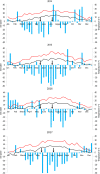Responses to climatic and pathogen threats differ in biodynamic and conventional vines
- PMID: 30442984
- PMCID: PMC6237997
- DOI: 10.1038/s41598-018-35305-7
Responses to climatic and pathogen threats differ in biodynamic and conventional vines
Abstract
Viticulture is of high socio-economic importance; however, its prevalent practices severely impact the environment and human health, and criticisms from society are raising. Vine managements systems are further challenged by climatic changes. Of the 8 million hectares grown worldwide, conventional and organic practices cover 90% and 9% of acreage, respectively. Biodynamic cultivation accounts for 1%. Although economic success combined with low environmental impact is widely claimed by biodynamic winegrowers from California, to South Africa, and France, this practice is still controversial in viticulture and scientific communities. To rethink the situation, we encouraged stakeholders to confront conventional and biodynamic paradigms in a Participative-Action-Research. Co-designed questions were followed up by holistic comparison of conventional and biodynamic vineyard managements. Here we show that the amplitude of plant responses to climatic threats was higher in biodynamic than conventional management. The same stood true for seasonal trends and pathogens attacks. This was associated with higher expression of silencing and immunity genes, and higher anti-oxidative and anti-fungal secondary metabolite levels. This suggests that sustainability of biodynamic practices probably relies on fine molecular regulations. Such knowledge should contribute to resolving disagreements between stakeholders and help designing the awaited sustainable viticulture at large.
Conflict of interest statement
The authors declare no competing interests.
Figures








Similar articles
-
Evaluation of the oenological suitability of grapes grown using biodynamic agriculture: the case of a bad vintage.J Appl Microbiol. 2016 Feb;120(2):355-65. doi: 10.1111/jam.13004. J Appl Microbiol. 2016. PMID: 26600207
-
The role of isotopic profiling in identifying organic and biodynamic practices in Vitis labrusca grape cultivation.Food Chem. 2025 May 15;474:143192. doi: 10.1016/j.foodchem.2025.143192. Epub 2025 Feb 3. Food Chem. 2025. PMID: 39923512
-
Soil microbiota respond to green manure in organic vineyards.J Appl Microbiol. 2017 Dec;123(6):1547-1560. doi: 10.1111/jam.13606. Epub 2017 Nov 3. J Appl Microbiol. 2017. PMID: 28990280
-
Organic and biodynamic wines quality and characteristics: A review.Food Chem. 2019 Oct 15;295:334-340. doi: 10.1016/j.foodchem.2019.05.149. Epub 2019 May 22. Food Chem. 2019. PMID: 31174766 Review.
-
Towards a Better Understanding of the Potential Benefits of Seaweed Based Biostimulants in Vitis vinifera L. Cultivars.Plants (Basel). 2022 Jan 27;11(3):348. doi: 10.3390/plants11030348. Plants (Basel). 2022. PMID: 35161328 Free PMC article. Review.
References
-
- Reeve Jennifer JR, et al. Soil and winegrape quality in biodynamically and organically managed vineyards. Am. J. Enol. Vitic. 2005;56:367–376.
Publication types
MeSH terms
Substances
LinkOut - more resources
Full Text Sources

